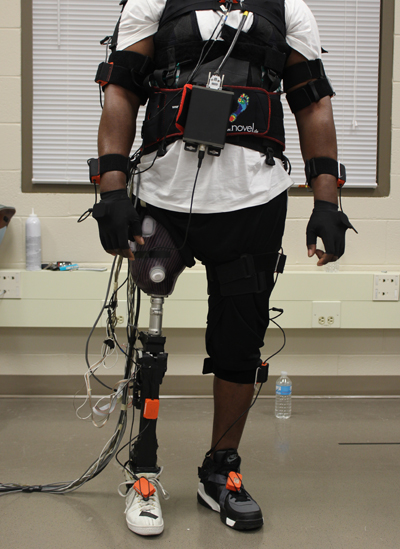For Immediate Release
Powered lower limb prosthetics hold promise for improving the mobility of amputees, but errors in the technology may also cause some users to stumble or fall. New research examines exactly what happens when these technologies fail, with the goal of developing a new generation of more robust powered prostheses.
“My work has focused on developing technology that translates electrical signals in human muscle into signals that control powered prosthetic limbs – such as decoding muscle signals to tell a prosthetic leg that it needs to walk forward or step up onto a staircase,” says Dr. Helen Huang, senior author of a paper on the work and an associate professor in the joint biomedical engineering program at North Carolina State University and the University of North Carolina at Chapel Hill.

“But sometimes this ‘decoding’ technology makes mistakes, such as thinking someone wants to climb a step when he doesn’t,” says Fan Zhang, lead author of the paper and a Ph.D. student in the joint biomedical engineering program. “This is a problem, because we don’t want to put users at risk of stumbling or falling.”
Huang’s team set out to understand exactly what happens to users of powered prosthetic legs when there’s an error in the decoding technology.
“We not only want to improve the decoding accuracy, but determine which errors are important and which have little or no impact on users,” Huang says. “Understanding the problem is an important step in finding ways to make these prostheses more reliable.”
To address the issue, the researchers had study subjects use a customized prosthetic device that was programmed to make errors. This was done in a lab setting that allowed Huang’s team to monitor each user’s balance and biomechanics. Users were also asked how stable they felt during each trial.
The researchers found that some errors were so insignificant that users didn’t even notice them – particularly errors that were short in duration or that occurred when a user’s weight was not being applied to the prosthetic leg.
But errors that lasted longer, or that occurred when a user’s weight was on the prosthetic limb, were more noticeable. The researchers also determined that critical, or especially noticeable, errors were also characterized by a large “mechanical work change,” meaning the prosthetic limb thought it had to do significantly more or less work than the user intended. Video of a “stable” test can be seen at https://www.youtube.com/watch?v=ZFka6AgrKdg&feature=youtu.be. Video of an “unstable” test can be seen at the top of the page, or at https://www.youtube.com/watch?v=-BnCa0cqZMg&feature=youtu.be.
“One of the things we’ll be doing as we move forward with this work is seek ways to limit that mechanical work change,” Huang says.
“Any system that involves a human interface will have occasional errors,” Huang notes. “But we think we can find ways to make those errors effectively insignificant.”
The paper, “Effects of Locomotion Mode Recognition Errors on Volitional Control of Powered Above-Knee Prostheses,” is published in early view online in the journal IEEE Transactions on Neural Systems and Rehabilitation Engineering. The paper was co-authored by Ming Liu, a laboratory manager in the joint biomedical engineering program. The work was supported by the National Science Foundation under grants number 1406750 and 1361549, by the Department of Defense under grant number W81XWH-09-2-0020, and by the National Institute on Disability and Rehabilitation Research under grant number H133G130308.
-shipman-
Note to Editors: The study abstract follows.
“Effects of Locomotion Mode Recognition Errors on Volitional Control of Powered Above-Knee Prostheses”
Authors: Fan Zhang, Ming Liu, and He Huang, North Carolina State University and the University of North Carolina at Chapel Hill
Published: forthcoming from IEEE Transactions on Neural Systems and Rehabilitation Engineering
DOI: 10.1109/TNSRE.2014.2327230
Abstract: Recent studies have reported various methods that recognize amputees’ intent regarding locomotion modes, which is potentially useful for volitional control of powered artificial legs. However, occasional errors in locomotion mode recognition are inevitable. When these intent recognition decisions are used for volitional prosthesis control, the effects of the decision errors on the operation of the prosthesis and user’s task performance is unknown. Hence, the goals of this study were to (1) systematically investigate the effects of locomotion mode recognition errors on volitional control of powered prosthetic legs and the user’s gait stability, and (2) identify the critical mode recognition errors that impact safe and confident use of powered artificial legs in lower limb amputees. Five able-bodied subjects and two above-knee (AK) amputees were recruited and tested when wearing a powered AK prosthesis. Four types of locomotion mode recognition errors with different duration and at different gait phases were purposely applied to the prosthesis control. The subjects’ gait stabilities were subjectively and objectively quantified. The results showed that not all of the mode recognition errors in volitional prosthesis control disturb the subjects’ gait stability. The effects of errors on the user’s balance depended on (1) the gait phase when the errors happened and (2) the amount of mechanical work change applied on the powered knee caused by the errors. Based on the study results, “critical errors” were defined and suggested as a new index to evaluate locomotion mode recognition algorithms for artificial legs. The outcome of this study might aid the future design of volitionally-controlled powered prosthetic legs that are reliable and safe for practice.
- Categories:


